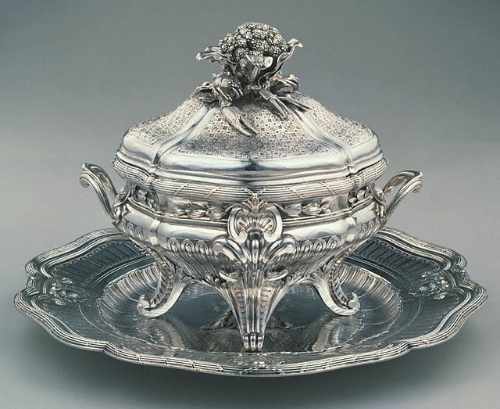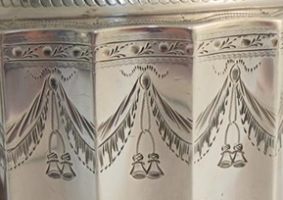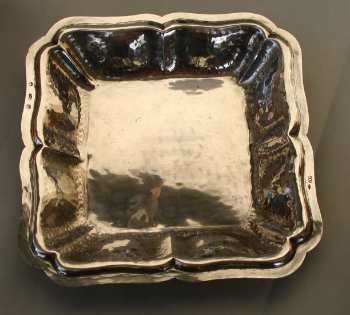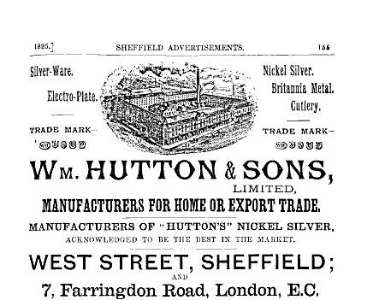|

Christophe Ginter presents:
Another imitation of Louis XV silver hallmarks (III) 
Une imitation de poinçons d'époque Louis XV (III) 
This new article presents a series of
apocryphal marks punched on a flat silver dish produced in Paris
in the late nineteenth or early twentieth century.
The dish with its lobed edges and double rim contour offers an
excellent representation of the taste of the eighteenth century
French silver workmanship......
click here  click
here click
here 
|
Welcome to new ASCAS members:
Ben Beiski - Israel
Elizabeth Ross Hubbell - USA
Sandra Meunier - England UK
Michael Trupp - USA
Althea Willette - USA
Donna Wills - USA
Members' Window # 87

Joanne and Emmett Eldred
present the third of their series of articles:
Our Collecting Guidelines - Engraving

Since we prefer pieces with armorial arms or crests, many of
the pieces we are considering have engraving.
The condition of the engraving is very important since it is key
component of the overall design statement. In evaluating
condition, we use a scale of 1-10, with 1 meaning the engraving
is barely discernable and 10 indicating it is almost perfect. We
would not typically purchase something with a rating of less
than 7. That means that all components of the engraving are
clearly visible and the only wear is where the engraving runs
over edges (and is prone to wear from polishing) or comes in
contact with another surface during normal usage. It also means
that any fine background lines are still present but maybe
slightly worn in spots (they tended to be cut very shallow)....
click here 
|
Gye-Alexandre Jacquot writes:
...I need the help of ASCAS member in my research of information about these items:
German Cup hallmarked city of Kassel, end of the 18th century, and an
unknown silversmith. There are also unidentified marks on each handle and two other very small
on the bottom.
The measures are: height with handle 14 cms, diameter 11 cms (base 7 cms). The inside is vermeil.
Cup with swan neck handles, Czeck work under Austria-Hungary Empire. There are seven marks:
a lozenge on each handle; a "F12" on the cup (750/1000 silver fineness, used 1806/1807);
an "F5" on the top edge and three other marks on the foot (IC?, F5, 12).
I'd wish to be confirmed in the dating of the piece and its use.
Any suggestion will be highly appreciated
Gye-Alexandre Jacquot
Sandra Sheek writes:
... I reached your beautiful web site through Google and hope you can help me, I just received a
3 part silver plate bun warmer I purchased on eBay, description was the following:
"SUPERB VICTORIAN SILVER PLATE BUN / MUFFIN WARMER
Up for auction is very fine a Victorian silver plated bun / muffin warmer by BRIDDON BROTHERS
(Sheffield Briddon Alfred & Frederick, from 1863-1910 at Victoria Plate Works). This lovely piece
has mechanical tri-section folding shell design and gold washed interior with pierced guards, on
tripod base. It also has lovely cherub finial and three angels in every corner. This warmer is
approx. 8 1/2" wide and 10 1/2" high. This warmer is in good original condition (no damages and
repairs) but has minor silver loss in the shell surface. Don't miss this lovely item !!"
My problem upon receiving it is, it very much looks like a REPRODUCTION, I am unaware if three part
bun warmers are being reproduced, and I'm certainly not an authority, but I am a collector of
beautiful ANTIQUE silver and this does not represent the look of an antique. The adv says 1863 to
1910, and I paid for an antique. The Hallmark is different than any you have pictured, the detail on
the trim and figures is very rough and sloppy and the inside seems very cheaply made. I have no
interest in owning or collecting reproductions, my figural antique pieces are all well detailed,
unlike this one. I've had to save along time to purchase a nice bun warmer and I don't know who else
to ask about this, and very much hope you might know if these bun warmers are being reproduced. I
thank you so much for any help or direction you might offer.
Sincerely Worried, Sandra
The seller of your item didn't well identify the maker's mark. The mark is not B BROS but C BROS
corresponding to Cooper Brothers (see my web site at
http://www.silvercollection.it/electroplatesilverCdue.html ).
This mark was used in the period 1867-1964, and is not possible to attribute an exact
date to silver plate marks. The period of manufacture of your piece lasts from mid 19th to mid
20th century.
Giorgio Busetto
Norma L. Young writes:
...Can anyone offer ideas on where this was made?
Oval bowl, on 4 hoof feet, gilded interior, 15cm wide and 7cm tall.
Date-wise circa 1780-1820.
A faint scratch-mark of S 5418, which could indicate weight or a model number.
I believe it was a sauce boat, given gilded interior and the finishing of the rim where a cover
could have been fitted.
Left punch mark is (prob.) a horse - one of front legs is poorly struck. Or could it be a standing
dog?
Right punch mark is maker of BM. Initials below of PF likely for its original owner.
Weight 5 troy oz.
Could it be Italian? German? Northern European such as Baltic/Scandinavian?
Thanks so much.
Norma L. Young
Karen S. Rabe writes:
...I recently acquired what I think is a 17th century goblet/cup without cover. I am unable to
identify the hallmarks. I believe it to be Continental. I have ruled out England and Germany.
I was wondering if anyone one in this group could give an opinion on age, country of origin on
this item. Is it a goblet?
I have seen similar items from around 1630-40 when wooden bodies were more prevalent.
The body is wooden and has a stabilized crack. It is marked with what appears to be crossed spoons
and each individual piece is double struck.. The foot rim separates from the goblet.
I believed the inscribed "16 TSA 30" mark is perhaps that of the owner.
It stands 9” tall and is 6” in diameter.
Thank you so much.
Karen
Christophe Ginter writes:
...Hello Giorgio, would any ASCAS fellow suggest a possible usage for this "bowl"?
High 12 cm+, weight ca. 400 grs.
Identified hallmarks are: sterling silver, date-letter for LONDON 1768, Master Thomas WALLIS I.
Many thanks in advance.
Christophe
I found this information:
according to Harold Newman (The illustrated dictionary of silverware) the "Two handled cup"
was used as loving cups on ceremonial occasions, as a prize for competitions, as award on special
occasions or merely as ornaments. Cups of such form but of much smaller size are sometimes called a
posset-pot or a caudle cup and too often in England have confusedly been called a porringer....
....The "small two-handled cups" are a type of circular cup that is of small size (about
10 to 18 cm high) and that has baluster or ogee shaped sides, two opposed vertical handles that
are thin and usually in the form of a debased caryatid handle and generally no cover.
Other information about the porringer are supplied by Giovanni Ciceri in ASCAS web site at
http://www.ascasonline.org/newsGIUGN49.html
Any further information by ASCAS members will be welcome.
Giorgio Busetto
Yosef Shlingbaum writes:
...I wondered if any member could assist me in the identification of
the marks of this item: origin, maker, Date, and use for.
I was told this is A Jewish "Spice Box" and it is very old (17 c.)??
Thank you
Yosef Shlingbaum
Your item is marked with "13" and a "lozenge". The "13" mark was used in German area (Germany and Austria) for
13 lot silver fineness (812,5/1000).
I am unable to identify the maker and to date the item (I do not believe it is 17th century. Possibly 19th century).
In my opinion it is a spice tower and, as you live in Israel, I believe that you can find there the most
qualified sources about its use.
Information ad images about Jewish ritual silver are available in ASCAS web site at
http://www.ascasonline.org/articoloAGO63.html
Any further suggestion will be appreciated.
Regards
Giorgio Busetto
Donna Wills writes:
...I have a piece that I would like your comment/opinion. It is Arlecchino but I cannot find anyone
who can give me an opinion of age or value.
It has a 4 ½ inch base with the engraved name "Brullu??". The base also has the following
stamped/engraved:
a small engraved rectangle with a "*52" then the letters "MC"
to the right of this is a stamped square with the letter "R" an oval with "800"
to the right of the "R", and the stamped number "20" to the right of the oval.
The piece is approximately 9 3/4 inches high including the base.
The Arlecchino has a multi colored patchwork costume – black pilgrim type shoes with gold laces, a
black mask, and a silver "matador" style hat.
His arms are crossed behind him with a sword type object in his hands that extends just above his
left shoulder.
Regards,
Donna Wills
Your Arlecchino was made in Italy by Brumal snc di Malizia R & C, Potenza Picena.
This piece is made with a thin sheet of silver filled and weighted with a resin.
The "R" is the symbol meaning "Riempito" (filled), and the "20" and
"800" mean that the precious metal is about 20 grams of silver of 800/1000 fineness.
The mark "star MC 52" (MC stands for the name of the province: Macerata) is used from
1970 onwards. The firm is still active in present days as Studio M srl (from 2002).
Information about the Italian silver marking system and the use of this technique is available in
my web site at http://www.silvercollection.it/italianhallmarks.html
Regards
Giorgio Busetto
Doug Gow writes:
...Just wondering if you could help me identify the maker of this WW1 German sweetheart badge?
The silver mark is .800. The other mark looks like a lizard or a crocodile
Many thanks!
Doug Gow
New Zealand
According to Waliczek-Rasala book the maker is Hepke & Lichtenfels - Pforzheim
(bijouterie- u.Knopffabrik).
Regards
Giorgio Busetto
In this column we present a page obtained from makers'
brochures, books, auction catalogs, advertising or whatever
other printed paper, related to silver, that may be of interest
for ASCAS members.
The images will be published at a "low resolution" level and for
private and personal use only

|
This month ASCAS presents an ancient advertisement
of
SIMONS BRO. & CO
616 Chesnut Street and 611 & 613 Sansom Street
Philadelphia
Silversmiths and Manufacturing Jewelers
In its advertisement the firm wrote that ... Although showing only Toilet Ware so far, we wish
Jewelers to understand that we are silversmiths in the fullest sense of the word making a full line of
Everything in Sterling Silverware....
Simons, Bro. & Co was established in 1840 by George W. Simons, father of John F., Frederick M. and
Edwin S. Simons, who later entered in the firm. The firm changed its name to George W. Simons & Bro
when Peter B. Simons joined to the business.
In 1908 the firm ceased the manufacture of flatware and patterns and dies were sold to Alvin Mfg. Co.
|
"A WORD per MONTH"

|
ITALIAN PSEUDO HALLMARKS
Since 1935 the Italian hallmarking silver is based on a number (e.g 800, identifying 800/1000 silver fineness)
and a sort of lozenge (in reality an oblong hexagon) containing two letters (the province code - until 1944 also a "fascio") and one or more digits
(the number identifying the maker).
The presence of a personal maker's mark (letters or symbol) is rare.
In objects manufactured in the 1950s/1960s sometimes can be found, besides the official hallmarks (800 and
lozenge), one or more pseudo-hallmarks similar to those used in the 19th century in Lombardo-Veneto.......
more
|
"A SILVERSMITH per MONTH"
|
|
WILLIAM HUTTON & SONS LTD
The firm was established in Birmingham by William Hutton in 1800 and transferred in Sheffield in 1832 where
the firm was active as manufacturing silversmiths and platers at 27 High Street (140-146 West Street from 1886).
After his death the business was continued under the same style by the founder's son William Carr Hutton until 1864,
when the name was changed to William Hutton & Son. This was a partnership of William Carr Hutton and his eldest son
Herbert Hutton (senior).
William Carr Hutton died in 1865 and c. 1870 Herbert Hutton Sr. was joined by his brothers Robert and
James Edward Hutton and the name was changed to William Hutton & Sons.
A London showroom was opened
in 1863 (13 Thavies Inn Holborn until 1891, and later 7 Farrington Road until 1918).....
more
|
"A BOOK ON MY SHELF"
In this column we present books, new
or ancient, dealing with silver in all its aspects (history,
marks, oddities...). This isn't a "book review" but only a fair
presentation of some useful "tools" that anyone may have in the
shelf of his bookcase.
ASCAS members are invited to contribute to this column
(click to enlarge images)
In the "book on my shelf" of this month ASCAS
presents:

|
FABERGÉ
TRÉSORS ET OBJETS DE FANTAISIE
by Géza Von Habsburg
(the text is in French language)
Editions Abbeville - New York - Paris - London
1996
|
If you like this newsletter, support ASCAS clicking on the
+1 button of google
Closing our August 2011 edition of
ASCAS Newsletter I hope you have appreciated its content.
Your comments, suggestions and advice will be of great help.
My thanks to Jayne Dye,
Joanne and Emmett Eldred, Christophe Ginter, Doug Gow, Gye-Alexandre Jacquot, Karen S. Rabe,
Sandra Sheek, Yosef Shlingbaum, Donna Wills, Norma L. Young, for their invaluable
contributions.
Giorgio Busetto
Secretary
DISCLAIMER AND PRIVACY POLICY
ASCAS is a community of people having a common
interest in antique silver.
It is a non-profit association without commercial links.
Membership is open to whomever has a true interest in
this subject matter.
ASCAS has no real property and no fees are requested nor
accepted from members.
ASCAS keeps in touch with its members only through
periodical newsletters, e-mails and web-site updating
and ignores and is not responsible for any other
activity pursued by its members.
Likewise, ASCAS is not responsible for opinions,
evaluation and images displayed, and in any form
published or supplied for publication, by its members
who, in any case, maintain the property of their works
and assure the respect of national and international
legislation about Intellectual Property.
ASCAS does not have the full addresses of its members (only
town, country and e-mail address are requested for
membership).
ASCAS handles and protects with care its members' e-mail
addresses, will not disclose the addresses to third
parties, will use this information only to reply to
requests received from members and for communications
strictly related to its activity.
These rules are expressly accepted by submitting the
membership request.
|
|
 newsletter
# 87 August 2011
newsletter
# 87 August 2011



















































